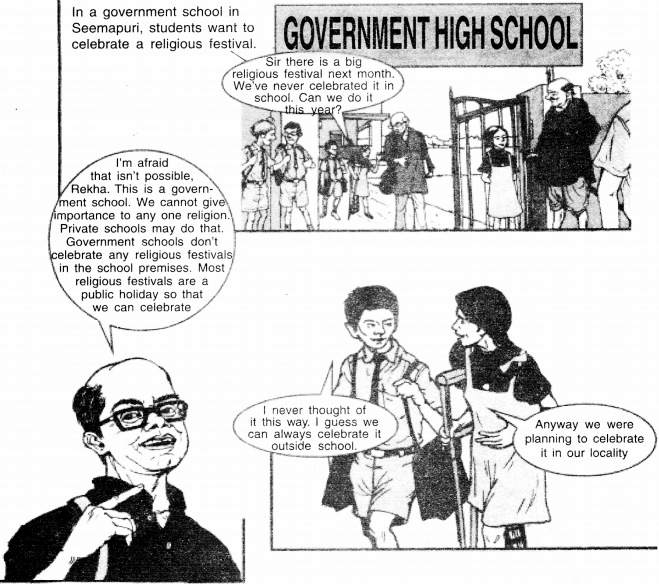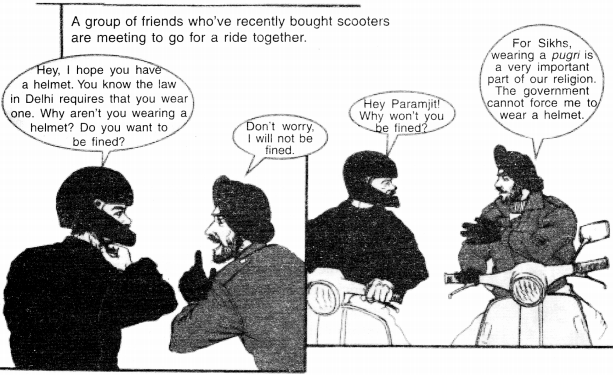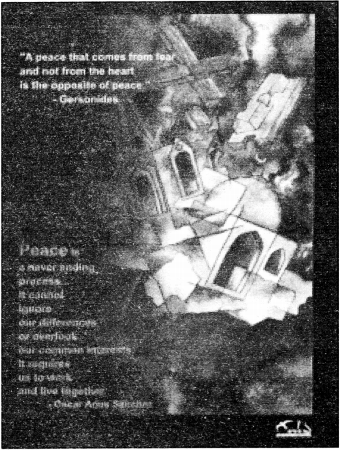Understanding Secularism Class 8 Questions and Answers Civics Chapter 2
Civics Class 8 Chapter 2 NCERT Textbook Questions and Answers
Question 1.
Re-read the introductions to this chapter. Why do you think retaliation is not the proper response to this problem? What would happen if different groups following this path?
Answer:
Retaliation is not the proper answer because it will lead to war and injustice. If different groups followed this path then the whole world will be a graveyard.
Question 2.
Discuss in class: can there be different views within the same religion.
Answer:
Yes, there can be different views within the same religion. For example, If there are two pandits or priests and if there is contridiction between their ideas, then there will be two groups opposing each other.
Read the following story board and answer the following question :

Question 3.
In the above story board, discuss the answer given by the teacher.
Answer:
Yes, the teacher is right. The goverment does not give right to goverment school to celebrate anyone festival. Now-a-days even in most of the schools mostly all the festivals of all the religions are celebrated.
Read the following story board and answer the following questions :

Question 4.
In the story board why Paramjit does not have to wear a helmet?
Answer:
Because the Indian State recognises that wearing a pugri is central to a Sikh’s religion practice and in order not to interfere with this, allows an exception in the law.
Question 5.
Government schools often have students from different religious back¬grounds. Re-read the three objectives of a secular state and write two sentences on why it is important that government schools do not promote
any one religion.
Answer:
In a government school children of all castes study. Giving preference to one religion would mean neglecting the other religions. Thus, in order to respect sentiments of all religions the government schools give equal preference to all religions.
Question 6.
Can you think of a recent, from any part of India, in which the secular ideals of the constitution were violated and persons were persented and killed because of their religions back grounds?
answer:
Yes, recently the secular ideals, of the constitution were violated in Mumbai. One religion party wanted to throw out the people of Bihar and Uttar Pradesh from their state.
Question 7.
List the different types of religions practice that you find in your neighbourhood. This could be different forms of prayer, worship of different god, sacred sites, different kinds of religious music and singing, etc. Does this indicate freedom of religions practise?
Answer:
Different types of religions practice in our neghbourhood are as follows :
(a) Jagran
(b) Kirtan
(c) Namaj
(d) Mass
(e) Havan
(f) Sai Sandhya
Yes, there no doubt indicate freedom of religions practice.
Question 8.
Will the government intervene if some religious group says that their religion allows them to practise infanticide? Give reasons for your answer.
Answer:
No doubt, the government will surely intervene if some religious groups says that their religion allows them to practise of infanticide. The practice of infanticide is a crime. In this practice the life of a newly-born child is killed. No law will allow anyone to kill.
Question 9.
Complete the following table.
| Objective | Why is this important | Example of a violation of this objective |
| One religions community does not dominate another. | ||
| The state does not enforce any particular religion our take away the religions freedom of individuals. | ||
| That some member dominate other members of the same religions community. |
Answer:
| Objective | Why is this important | Example of a violation of this objective |
| One religions community does not dominate another. | This is important for establishing harmony in society. | A Muslim family living among the Hindu community in a locality is forbidden to offer namaj.
A Hindu religion profession is not allowed to pass along the road where a mosque is isituated. |
| The state does not enforce any particular religion our take away the religions freedom of individuals. | This is important in order to stabilise the ideals of the Indian Constitution. | Demolition of the Babri Masjid. |
| That some member dominate other members of the same religions community. | This is important to establish equality in the society. | Some untouchables are not allowed to enter temples. |
Question 10.
Look up the annual calendar of holidays of your school. How many of them pertain to different religions? What does this indicate.
Answer:
The holidays in a school calendar for different religions are as follows :
| Religion | Holiday’s |
| 1. Hindu | Holi, Dussehra, Deepawali, Janamastmi, Rakshabandhan, Bhaiya Dooj, Ram Navami. |
| 2. Muslim | Id-ul-zoha, Id-ul-fitr, Muharram. |
| 3. Sikh | Lohri, Guru Parv, Guru Gobind Singh Jayanti. |
| 4. Christian | Good Friday, Christmas. |
Question 11.
Find out some examples of different views within the same religion.
Answer:
Yes, different views are followed even with the same religion. For example, in the Hindu religion, we have hundreds of dieties worshipped by the same people. In the Muslim community, there are too, Shiyas and Shunnis. In Buddha Dharma, there are Hinayans and Mahayans and Jains there are Shwetamber and Digamber.
Question 12.
The Indian State both keeps away from religion and well as intervenes in religion. This idea can be quite confusing. Discuss this once again in class using examples from the chapter as well as those that you might have come up with.
Answer:
India is a land of different castes, religions, ideals etc. There are many ideals in the constitution but practises are quiet different from them. Sometimes we see laws explain a concept in a different way, but there are interpreted by the people differently. In some cases law itself acts differently. For eaxmple in a secular state law has nothing to say in any of the religions practices but when the dominance of upper castes in religion was brought to questions the lower castes were favoured by law. This interference of the state sometimes creates confusion.
Question 13.
This poster alongside highlight the need for ‘peace’. It says, “Peace is a never-ending process…. It cannot ignore our differences or overlook our common interests.” Write in your own words what you think the above sentences are trying to convey? How does it relate to the need for religious toleremce?

This chapter had three drawings on religious tolerance made by students of your age. Design your own poster on religious tolerance for your peers.
Answer:
The poster given conveys a message for the establishment of peace in the whole society. The message potrays that peace is a long-cherished process. However, in this progress they cannot ignore the differences or overlook our own common interests. It means that peace can be brought only after establishing a link between the common interests. The most sensitive issue in this sence is religious tolerance.
Students shall design their own posters on religious tolerance.